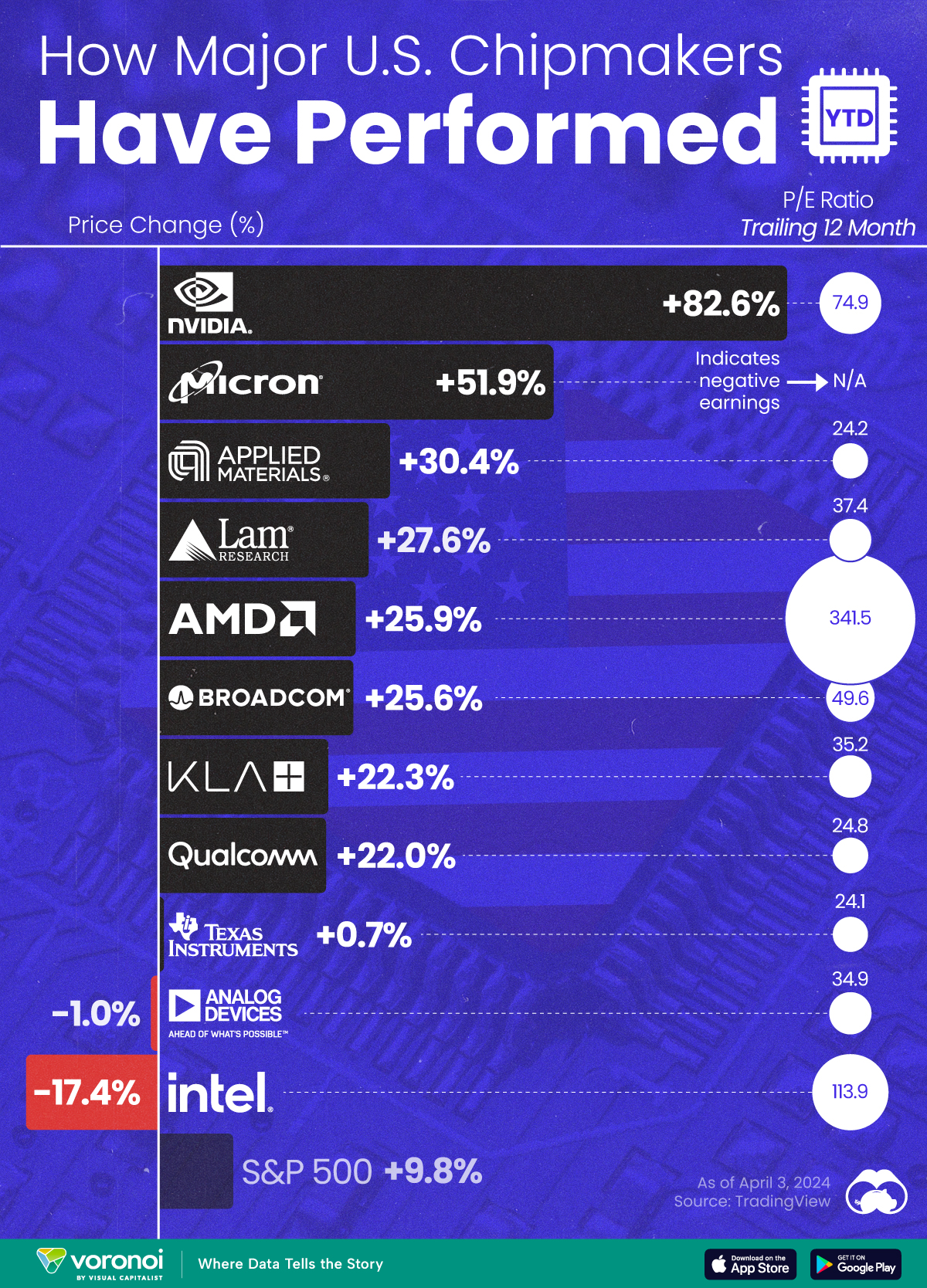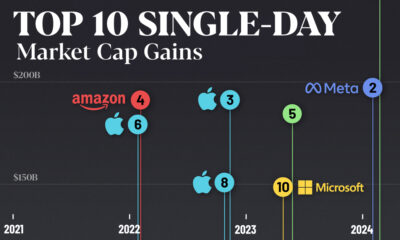Technology
The Stock Performance of U.S. Chipmakers So Far in 2024
![]() See this visualization first on the Voronoi app.
See this visualization first on the Voronoi app.
The Stock Performance of U.S. Chipmakers So Far in 2024
This was originally posted on our Voronoi app. Download the app for free on iOS or Android and discover incredible data-driven charts from a variety of trusted sources.
Is there anything more wanted than a chip stock right now? Four of the biggest U.S. chipmakers have accounted for a staggering one-third of the S&P 500 gains in 2024 so far.
But what does that look like for the individual companies?
We visualize the year-to-date (YTD) stock performance of major American chipmakers, ranked by market cap. Price-earnings ratios (trailing 12 months) were included for additional context. Data is sourced from TradingView, current up to April 3rd, 2024.
America’s Biggest Chip Stocks See Strong Growth 2024
The Nvidia rocket ship is refusing to slow down; the stock is up almost 80% YTD in 2024. This is after its more than threefold rise last year, joining the trillion dollar club in May 2023.
However, Nvidia’s isn’t the only one amongst the big U.S. chipmakers to have a strong Q1 stock performance. Micron Technology (memory chips) and Applied Materials (manufacturing equipment) also posted big gains on Wall Street.
| Company | Price Change (Since Jan 1, 2024) | P/E Ratio (Trailing 12 Month) |
|---|---|---|
| Nvidia | 82.6% | 74.9 |
| Micron Technology | 51.9% | N/A |
| Applied Materials | 30.4% | 24.2 |
| Lam Research | 27.6% | 37.4 |
| AMD | 25.9% | 341.5 |
| Broadcom | 25.6% | 49.6 |
| KLA | 22.3% | 35.2 |
| Qualcomm | 22% | 24.79 |
| Texas Instruments | 0.7% | 24.1 |
| Analog Devices | -1% | 34.9 |
| Intel | -17.4% | 113.9 |
| S&P 500 | 9.8% | N/A |
Many of these firms have benefited from the ongoing AI craze, as well the U.S. government’s efforts to ramp-up domestic chipmaking capacity.
The one big outlier to this is Intel, who has been having a rough couple of years. Its foundry business—which makes chips for competitors—has been losing money, scaring off investors from a stock with an already fairly high P/E ratio.
What Does the P/E Ratio Tell Us?
The price-earnings ratio is the proportion of a company’s stock price to its earnings per share (EPS).
We’ve visualized the trailing 12 month (TTM) P/E ratio, which divides current stock price by EPS over the past 12 months. The one downside to this metric is some fundamental stock market wisdom—past performance doesn’t determine future earnings.
In terms of P/E ratios, AMD and Intel are the two outliers at 341.5 and 113.9 respectively. In AMD’s case, this means that investors are willing to pay $341.5 per $1 of earnings.
This is substantially higher than all of the other companies on this list, suggesting that investors expect AMD to grow a lot in the future.
Technology
Charting the Next Generation of Internet
In this graphic, Visual Capitalist has partnered with MSCI to explore the potential of satellite internet as the next generation of internet innovation.

Could Tomorrow’s Internet be Streamed from Space?
In 2023, 2.6 billion people could not access the internet. Today, companies worldwide are looking to innovative technology to ensure more people are online at the speed of today’s technology.
Could satellite internet provide the solution?
In collaboration with MSCI, we embarked on a journey to explore whether tomorrow’s internet could be streamed from space.
Satellite Internet’s Potential Customer Base
Millions of people live in rural communities or mobile homes, and many spend much of their lives at sea or have no fixed abode. So, they cannot access the internet simply because the technology is unavailable.
Satellite internet gives these communities access to the internet without requiring a fixed location. Consequently, the volume of people who could get online using satellite internet is significant:
| Area | Potential Subscribers |
|---|---|
| Households Without Internet Access | 600,000,000 |
| RVs | 11,000,000 |
| Recreational Boats | 8,500,000 |
| Ships | 100,000 |
| Commercial Aircraft | 25,000 |
Advances in Satellite Technology
Satellite internet is not a new concept. However, it has only recently been that roadblocks around cost and long turnaround times have been overcome.
NASA’s space shuttle, until it was retired in 2011, was the only reusable means of transporting crew and cargo into orbit. It cost over $1.5 billion and took an average of 252 days to launch and refurbish.
In stark contrast, SpaceX’s Falcon 9 can now launch objects into orbit and maintain them at a fraction of the time and cost, less than 1% of the space shuttle’s cost.
| Average Rocket Turnaround Time | Average Launch/Refurbishment Cost | |
|---|---|---|
| Falcon 9* | 21 days | < $1,000,000 |
| Space Shuttle | 252 days | $1,500,000,000 (approximately) |
Satellites are now deployed 300 miles in low Earth orbit (LEO) rather than 22,000 miles above Earth in Geostationary Orbit (GEO), previously the typical satellite deployment altitude.
What this means for the consumer is that satellite internet streamed from LEO has a latency of 40 ms, which is an optimal internet connection. Especially when compared to the 700 ms stream latency experienced with satellite internet streamed from GEO.
What Would it Take to Build a Satellite Internet?
SpaceX, the private company that operates Starlink, currently has 4,500 satellites. However, the company believes it will require 10 times this number to provide comprehensive satellite internet coverage.
Charting the number of active satellites reveals that, despite the increasing number of active satellites, many more must be launched to create a comprehensive satellite internet.
| Year | Number of Active Satellites |
|---|---|
| 2022 | 6,905 |
| 2021 | 4,800 |
| 2020 | 3,256 |
| 2019 | 2,272 |
| 2018 | 2,027 |
| 2017 | 1,778 |
| 2016 | 1,462 |
| 2015 | 1,364 |
| 2014 | 1,262 |
| 2013 | 1,187 |
Next-Generation Internet Innovation
Innovation is at the heart of the internet’s next generation, and the MSCI Next Generation Innovation Index exposes investors to companies that can take advantage of potentially disruptive technologies like satellite internet.
You can gain exposure to companies advancing access to the internet with four indexes:
- MSCI ACWI IMI Next Generation Internet Innovation Index
- MSCI World IMI Next Generation Internet Innovation 30 Index
- MSCI China All Shares IMI Next Generation Internet Innovation Index
- MSCI China A Onshore IMI Next Generation Internet Innovation Index
MSCI thematic indexes are objective, rules-based, and regularly updated to focus on specific emerging trends that could evolve.

Click here to explore the MSCI thematic indexes

-

 Technology2 weeks ago
Technology2 weeks agoCountries With the Highest Rates of Crypto Ownership
While the U.S. is a major market for cryptocurrencies, two countries surpass it in terms of their rates of crypto ownership.
-

 Technology2 weeks ago
Technology2 weeks agoMapped: The Number of AI Startups By Country
Over the past decade, thousands of AI startups have been funded worldwide. See which countries are leading the charge in this map graphic.
-

 Technology3 weeks ago
Technology3 weeks agoAll of the Grants Given by the U.S. CHIPS Act
Intel, TSMC, and more have received billions in subsidies from the U.S. CHIPS Act in 2024.
-

 Technology4 weeks ago
Technology4 weeks agoVisualizing AI Patents by Country
See which countries have been granted the most AI patents each year, from 2012 to 2022.
-

 Technology4 weeks ago
Technology4 weeks agoHow Tech Logos Have Evolved Over Time
From complete overhauls to more subtle tweaks, these tech logos have had quite a journey. Featuring: Google, Apple, and more.
-

 AI1 month ago
AI1 month agoRanked: Semiconductor Companies by Industry Revenue Share
Nvidia is coming for Intel’s crown. Samsung is losing ground. AI is transforming the space. We break down revenue for semiconductor companies.
-

 United States7 days ago
United States7 days agoMapped: Countries Where Recreational Cannabis is Legal
-

 Healthcare2 weeks ago
Healthcare2 weeks agoLife Expectancy by Region (1950-2050F)
-

 Markets2 weeks ago
Markets2 weeks agoThe Growth of a $1,000 Equity Investment, by Stock Market
-

 Markets2 weeks ago
Markets2 weeks agoMapped: Europe’s GDP Per Capita, by Country
-

 Money2 weeks ago
Money2 weeks agoCharted: What Frustrates Americans About the Tax System
-

 Technology2 weeks ago
Technology2 weeks agoCountries With the Highest Rates of Crypto Ownership
-

 Mining2 weeks ago
Mining2 weeks agoWhere the World’s Aluminum is Smelted, by Country
-

 Personal Finance2 weeks ago
Personal Finance2 weeks agoVisualizing the Tax Burden of Every U.S. State












